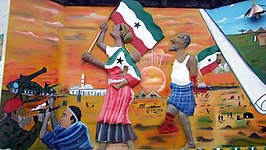Result
Sinjar massacre

Sinjar massacre
20/02/2022 14:51:12Major insurgent attacks
...Sivas massacre

Sivas massacre
20/02/2022 14:49:17The Sivas massacre (Turkish: Sivas Katliamı) or Madımak massacre (Turkish: Madımak Katliamı) refers to the events of July 2, 1993 at the Hotel Madimak (Otel Madımak) in Sivas, Turkey, which resulted in the killing of 37 people, mostly Alevi intellectuals. Two perpetrators also died during the incident. The victims, who had gathered in the hotel for the Pir Sultan Abdal festival, were killed when a mob set fire to the hotel.
Sobane Da massacre

Sobane Da massacre
20/02/2022 14:51:22On 10 June 2019, the Dogon village of Sobane Da in Mali was attacked. Moulaye Guindo, mayor of neighbouring Bankass, blamed a Fulani militia group. The attack killed 35 people, revised from an earlier claim of 95 killed with 19 missing. A survivor said the attackers numbered about 50, driving motorbikes and pickup trucks. The government of Mali has suspected that terrorists have committed the attack.
Solhan and Tadaryat massacres
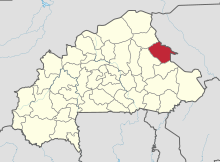
Solhan and Tadaryat massacres
20/02/2022 14:51:29On 4 and 5 June 2021, insurgents attacked the Solhan and Tadaryat villages in the Yagha Province of Burkina Faso. The massacres left at least 174 people dead. Insurgents have been attacking the Sahel Region, along the border with Mali, since Islamists captured parts of Mali in 2013.
Somaliland War of Independence

Somaliland War of Independence
20/02/2022 14:49:00SNM victory
- End of Isaaq Genocide
- Collapse of the Somali Democratic Republic
- Grand Conference of the Northern Clans held in Burao ends major combat operations
(10 years, 1 months, and 12 days)
| Date | 6 April 1981 – 18 May 1991 (10 years, 1 months, and 12 days) |
|---|---|
| Location | Northern Somalia (now Somaliland) |
| Result |
SNM victory
|
| Territorial changes | Somaliland regains independence; Somalia loses 27.6% of its territory |
40,000 (1987)
Numerous South African and Rhodesian mercenaries3,000-4,000 (1982-1988)
99,000-100,000 (1991)Casualties:
50,000–100,000 due to the Isaaq Genocide
High estimates range between 100,000–200,000
500,000 refugees
400,000 internally displaced
Introduction
Sook Ching

Sook Ching
20/02/2022 14:43:23Sook Ching was a mass killing that occurred from 18 February to 4 March 1942 in Singapore after it fell to the Japanese. It was a systematic purge and massacre of perceived "hostile elements" in Singapore, with the Singaporean Chinese particularly targeted by the Japanese military during the occupation. Singapore was a crucial strategic point in World War II. From 8 February to 15 February, the Japanese had fought for control of the city. The combined British and Commonwealth forces surrendered in a stunning defeat to the outnumbered Japanese on 15 February which led to its fall. The loss of Singapore was and still is Britain's largest surrender in history.
Three days later after the fall on 18 February, the occupying Japanese military began mass killings of a wide range of "undesirables", who were mostly ethnic Chinese, influenced by the events of the Second Sino-Japanese War that was raging simultaneously as far back as 1937. The operation was overseen by the Imperial Japanese Army's Kempeitai, its secret police. Along with Singapore, Sook Ching was subsequently also extended to include the Chinese population in Malaya, which was also under occupation by the Japanese. Concurrently, non-Chinese individuals were also not completely spared in other parts of Asia under Japanese occupation; the Japanese had also killed at least 150,000 Tamil Indians as well as an additional 90,000 civilians in Burma and Thailand, many of which were also forced to work on the Siam–Burma Railway, infamously known as the Death Railway.
...Soweto uprising

Soweto uprising
20/02/2022 14:48:19The Soweto uprising was a series of demonstrations and protests led by black school children in South Africa that began on the morning of 16 June 1976.
Students from numerous Sowetan schools began to protest in the streets of Soweto in response to the introduction of Afrikaans as the medium of instruction in local schools. It is estimated that 20,000 students took part in the protests. They were met with fierce police brutality and many were shot and killed. The number of people killed in the uprising is usually given as 176, but estimates of up to 700 have been made. In remembrance of these events, 16 June is now a public holiday in South Africa, named Youth Day.
Srebrenica massacre
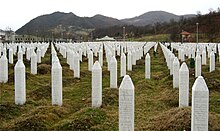
Srebrenica massacre
20/02/2022 14:50:30The Srebrenica massacre (Serbo-Croatian: Masakr u Srebrenici / Масакр у Сребреници), also known as the Srebrenica genocide (Serbo-Croatian: Genocid u Srebrenici / Геноцид у Сребреници), was the July 1995 genocidal killing of more than 8,000 Bosniak Muslim men and boys in and around the town of Srebrenica, during the Bosnian War.
The killings were perpetrated by units of the Bosnian Serb Army of Republika Srpska (VRS) under the command of Ratko Mladić. The Scorpions, a paramilitary unit from Serbia, who had been part of the Serbian Interior Ministry until 1991, also participated in the massacre. Prior to the massacre, United Nations (UN) had declared the besieged enclave of Srebrenica, in eastern Bosnia, a "safe area" under UN protection. However, the UN failed both to demilitarize the Army of the Republic of Bosnia and Herzegovina (ARBiH) within Srebrenica and to force withdrawal of the VRS surrounding Srebrenica. UNPROFOR's 370 lightly armed Dutchbat soldiers were unable to prevent the town’s capture and the subsequent massacre. A list of missing or killed people during the massacre compiled by the Bosnian Federal Commission of Missing Persons contains 8,372 names. As of July 2012[update], 6,838 genocide victims have been identified through DNA analysis of body parts recovered from mass graves; as of July 2021[update], 6,671 bodies have been buried at the Memorial Centre of Potočari, while another 236 have been buried elsewhere.
...Stabbing of Salman Rushdie

Stabbing of Salman Rushdie
14/08/2022 05:01:36On August 12, 2022, a man stabbed Indian-born British-American novelist Salman Rushdie multiple times as he was about to give a public lecture at the Chautauqua Institution in Chautauqua, New York, United States. The co-founder of City of Asylum, Henry Reese, who was also onstage and about to begin interviewing Rushdie, sustained a minor head injury during the assault. A New York state trooper and a sheriff's deputy, who were both present when the attack occurred, arrested a 24-year-old man — identified as Hadi Matar — at the scene. Matar was charged the following day with attempted murder and assault.
An air ambulance flew Rushdie to a hospital in nearby Erie, Pennsylvania. The novelist — having sustained damage to numerous organs, including to his liver and to one of his eyes — underwent surgery and was placed on a ventilator. The day after Rushdie was stabbed, his literary agent, Andrew Wylie, confirmed to the Associated Press that Rushdie had been taken off the ventilator and was able to speak.
...Storming of Bolton

Storming of Bolton
20/02/2022 14:39:061643
- Braddock Down
- Leeds
- 1st Middlewich
- Hopton Heath
- Seacroft Moor
- Camp Hill
- Lichfield
- Ripple Field
- Reading
- Sourton Down
- 1st Wardour Castle
- Stratton
- Wakefield
- 1st Worcester
- Chalgrove Field
- Adwalton Moor
- Burton Bridge
- Lansdowne
- Roundway Down
- 1st Bristol
- Gainsborough
- Gloucester
- 2nd Hull
- Aldbourne Chase
- 1st Newbury
- Winceby
- Olney Bridge
- 1st Basing House
- Heptonstall
- 2nd Wardour Castle
- Alton
- Bramber Bridge
- Arundel
- 2nd Middlewich
Sugarloaf massacre

Sugarloaf massacre
20/02/2022 14:39:24The Sugarloaf massacre was a skirmish that occurred on September 11, 1780, in the U.S. state of Pennsylvania when a number of Natives and a handful of loyalists attacked a small detachment of militia from Northampton County. According to pension files and witness depositions, the militia detachment was led by Lieutenants John Moyer and John Fish of Captain Johannes Van Etten's company of volunteers.
Sutherland Springs church shooting

Sutherland Springs church shooting
14/02/2022 16:31:59The Sutherland Springs church shooting occurred on November 5, 2017, when Devin Patrick Kelley of New Braunfels, Texas perpetrated a mass shooting at the First Baptist Church in Sutherland Springs, Texas. Kelley killed 26 people, including an unborn child, and wounded 22 others before dying of a self-inflicted gunshot wound. The attack is the deadliest mass shooting in Texas history, and the fifth-deadliest in the United States. It was the deadliest shooting in an American place of worship in modern history, surpassing the Charleston church shooting of 2015 and the Waddell Buddhist temple shooting of 1991.
Kelley was prohibited by law from purchasing or possessing firearms and ammunition due to a domestic violence conviction in a court-martial while in the United States Air Force. The Air Force failed to record the conviction in the Federal Bureau of Investigation (FBI) National Crime Information Center database, which is used by the National Instant Check System to flag prohibited purchases. The error prompted the Air Force to begin a review.
...Tadmor Prison

Tadmor Prison
20/02/2022 14:48:29Tadmor prison (Arabic: سجن تدمر) was located in Palmyra (Tadmor in Arabic) in the deserts of eastern Syria approximately 200 kilometers northeast of Damascus.
Tadmor prison was known for harsh conditions, extensive human rights abuse, torture and summary executions. A 2001 report by Amnesty International called it a source of "despair, torture and degrading treatment."
It was captured and destroyed by militants of the Islamic State of Iraq and the Levant (ISIL) in May 2015.
Tantura massacre

Tantura massacre
20/02/2022 14:45:48The Tantura massacre took place on May 23, 1948, when around 200 Palestinian Arabs were massacred in Tantura, a village of roughly 1500 people (in 1945) near Haifa, by the Israeli Defense Force's Alexandroni Brigade.
Thibodaux massacre

Thousand Oaks shooting

Thousand Oaks shooting
14/02/2022 16:32:00On November 7, 2018, a mass shooting occurred in Thousand Oaks, California, United States, at the Borderline Bar and Grill, a country-western bar frequented by college students. Thirteen people were killed, including the perpetrator, who died of a self-inflicted gunshot wound, and a police officer who was shot multiple times, with the fatal wound accidentally being fired by another officer. One other person sustained a gunshot wound, while fifteen others were injured by incidental causes.
Police identified the killer as 28-year-old Ian David Long, a United States Marine Corps veteran.
Tlatelolco massacre

Tlatelolco massacre
20/02/2022 14:48:01On October 2, 1968 in the Tlatelolco section of Mexico City, the Mexican Armed Forces opened fire on a group of unarmed civilians in the Plaza de las Tres Culturas who were protesting the upcoming 1968 Summer Olympics. The Mexican government and media claimed that the Armed Forces had been provoked by protesters shooting at them, but government documents made public since 2000 suggest that snipers had been employed by the government.
The number of deaths resulting from the event is disputed. According to U.S. national security archives, American analyst Kate Doyle documented the deaths of 44 people; however, estimates of the actual death toll range from 300 to 400, with eyewitnesses reporting hundreds dead. Additionally the head of the Federal Directorate of Security reported that 1,345 people were arrested.
The massacre followed a series of large demonstrations called the Mexican Movement of 1968 and is considered part of the Mexican Dirty War, when the U.S.-backed Institutional Revolutionary Party (PRI) government violently repressed political and social opposition. The event occurred ten days before the opening ceremony of the Olympics, which were carried out normally.
...Tsuyama massacre

Tsuyama massacre
20/02/2022 14:43:02The Tsuyama massacre (津山事件, Tsuyama jiken) was a revenge spree killing that occurred on 21 May 1938 in the rural village of Kamo close to Tsuyama in Okayama, Empire of Japan.
Mutsuo Toi (都井 睦雄, Toi Mutsuo), a 21-year-old man, killed 30 people, including his grandmother, with a Browning shotgun, katana, and axe, and seriously injured three others before killing himself with the shotgun. It is the deadliest shooting by a lone gunman in Japanese history.
Tulsa race massacre
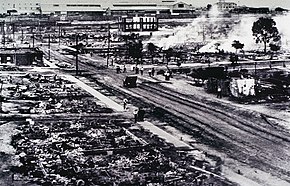
Tulsa race massacre
20/02/2022 14:42:33The Tulsa race massacre took place on May 31 and June 1, 1921, when mobs of white residents, some of whom had been deputized and given weapons by city officials, attacked Black residents and destroyed homes and businesses of the Greenwood District in Tulsa, Oklahoma, US. Alternatively known as the Tulsa pogrom, the Tulsa race riot or the Black Wall Street massacre, the event is considered one of "the single worst incident[s] of racial violence in American history". The attackers burned and destroyed more than 35 square blocks of the neighborhood – at the time one of the wealthiest Black communities in the United States, known as "Black Wall Street".
More than 800 people were admitted to hospitals, and as many as 6,000 Black residents of Tulsa were interned in large facilities, many of them for several days. The Oklahoma Bureau of Vital Statistics officially recorded 36 dead. A 2001 state commission examination of events was able to confirm 39 dead, 26 Black and 13 white, based on contemporary autopsy reports, death certificates, and other records. The commission gave several estimates ranging from 75 to 300 dead.
The massacre began during the Memorial Day weekend after 19-year-old Dick Rowland, a Black shoeshiner, was accused of assaulting Sarah Page, the 17-year-old white elevator operator in the nearby Drexel Building. He was taken into custody. After Rowland was arrested, rumors that stated that he was going to be lynched were spread throughout the city, which had seen a white man named Roy Belton lynched the previous year. Upon hearing reports that a mob of hundreds of white men had gathered around the jail where Rowland was being held, a group of 75 Black men, some of whom were armed, arrived at the jail in order to ensure that Rowland would not be lynched. The sheriff persuaded the group to leave the jail, assuring them that he had the situation under control. An elderly white man approached O.B. Mann, a Black man, and demanded that he hand over his pistol. Mann refused, and the old man attempted to disarm him. Mann shot him, and then, according to the sheriff's reports, "all hell broke loose." At the end of the exchange of gunfire, 12 people were dead, 10 White and two Black. Subsequently the militants fled back into Greenwood shooting as they went. As news of the violence spread throughout the city, mob violence exploded. White rioters invaded Greenwood that night and the next morning, killing men and burning and looting stores and homes. Around noon on June 1, the Oklahoma National Guard imposed martial law, ending the massacre.
...University of Texas tower shooting
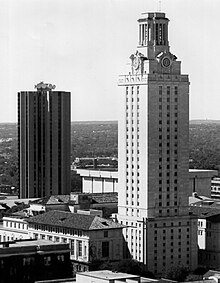
University of Texas tower shooting
20/02/2022 14:47:52On August 1, 1966, after stabbing his mother and his wife to death the night before, Charles Whitman, a Marine veteran, took rifles and other weapons to the observation deck atop the Main Building tower at the University of Texas at Austin, and then opened fire indiscriminately on people on the surrounding campus and streets. Over the next 96 minutes he shot and killed 15 people, including an unborn child and one final victim who died from his injuries in 2001. Whitman also injured 31 others. The incident ended when a policeman and a civilian reached Whitman and shot him dead. At the time, the attack was the deadliest mass shooting by a lone gunman in U.S. history, being surpassed 18 years later by the San Ysidro McDonald's massacre.
It has been suggested that Whitman's violent impulses, with which he had been struggling for several years, were caused by a tumor found in the white matter above his amygdala upon autopsy.
...Utah prisoner of war massacre
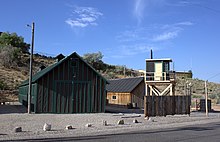
Utah prisoner of war massacre
14/02/2022 16:32:01The Utah prisoner of war massacre (headlined by Time as Midnight Massacre) took place after the end of World War II in Europe at midnight on July 8, 1945 at a German and Italian prisoner-of-war camp in Salina, Utah. Nine German prisoners of war were murdered and nineteen prisoners were wounded by American private Clarence V. Bertucci, who was on active duty in the camp. After a night out, Bertucci returned to camp around midnight to assume his night duty at the guard tower. Bertucci subsequently loaded the .30-caliber M1917 Browning machine gun on the tower and fired at the tents of the sleeping prisoners. After the massacre, he revealed his motivation was that, "he had hated Germans, so he had killed Germans." Six Germans were immediately killed, two died in Salina's hospital, one died in an army hospital, and nineteen were wounded.
The victims were buried with full military honors at the Fort Douglas Cemetery. Wounded prisoners were sent back to Germany after they were healthy enough to travel. After the massacre, Bertucci was taken into custody with little resistance. He was evaluated for a few weeks, before doctors determined that he was "mentally unbalanced." Military officers forwent a court-martial on account of insanity and he was sent to Mason General Hospital in New York for an undisclosed amount of time. The Midnight Massacre is remembered for being "the worst massacre at a POW camp in U.S. history" and represented the largest killing of enemy prisoners in the United States during World War II. A museum was opened at Camp Salina in 2016.
...Uzbin Valley ambush

Virginia Tech shooting

Virginia Tech shooting
20/02/2022 14:50:57Coordinates: 37°13′37″N 80°25′19″W / 37.227°N 80.422°WThe Virginia Tech shooting was a spree shooting that occurred on April 16, 2007, comprising two attacks on the campus of the Virginia Polytechnic Institute and State University in Blacksburg, Virginia, United States. Seung-Hui Cho, an undergraduate student at the university and a U.S. resident of South Korean descent, killed 32 people and wounded 17 others with two semi-automatic pistols. Six others were injured jumping out of windows to escape Cho.
...Vukovar massacre

Vukovar massacre
20/02/2022 14:49:051992
1993
1994
1995
Vyborg massacre

Vyborg massacre
20/02/2022 14:42:23The Vyborg massacre was the killing of approximately 360 to 420 Russians in the town of Vyborg during the Finnish Civil War in April–May 1918. The massacre took place during and after the Battle of Vyborg as the White Guards captured the town from the Red Guards. At least half of the victims were Russian soldiers and military personnel. The slain were mainly men and young boys: nine out of ten were men fit for military service. The White Guards were "cleansing" the city of Red Guards, however, only a small minority of the killed Russian townsfolk were affiliated with the Finnish labour movement.
Waco siege
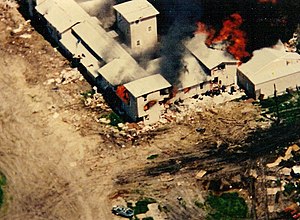
Waco siege
20/02/2022 14:49:15The Waco siege, also known as the Waco massacre, was the law enforcement siege of the compound that belonged to the religious sect Branch Davidians. It was carried out by the U.S. federal government, Texas state law enforcement, and the U.S. military, between February 28 and April 19, 1993. The Branch Davidians were led by David Koresh and were headquartered at Mount Carmel Center ranch in the community of Axtell, Texas, 13 miles (21 kilometers) northeast of Waco. Suspecting the group of stockpiling illegal weapons, the Bureau of Alcohol, Tobacco, and Firearms (ATF) obtained a search warrant for the compound and arrest warrants for Koresh, as well as a select few of the group's members.
...Wagalla massacre

Wagalla massacre
20/02/2022 14:48:37The Wagalla massacre was a massacre on ethnic Somalis by the Kenyan Army on 10 February 1984 in Wajir County, Kenya. Daniel arap Moi opened barracks near Wagalla, where he brought soldiers to 'discipline the villagers'.
Wah Mee massacre

Wah Mee massacre
20/02/2022 14:48:35The Wah Mee massacre (traditional Chinese: 華美大屠殺; simplified Chinese: 华美大屠杀; Jyutping: Wa4mei5 daai6tou4saat3; pinyin: Huáměi dàtúshā) was a multiple homicide that occurred during the night of February 18–19, 1983, in which Kwan Fai "Willie" Mak, Wai-Chiu "Tony" Ng, and Benjamin Ng (no relation) bound, robbed, and shot fourteen people in the Wah Mee gambling club at the Louisa Hotel in Chinatown-International District, Seattle. Thirteen of their victims died, but Wai Chin, a dealer at the Wah Mee, survived to testify against the three in the separate high-profile trials held in 1983 and 1985. It is the deadliest mass murder in Washington state history.
Weenen massacre

Weenen massacre
20/02/2022 14:39:50Battles
Wehda Street airstrikes
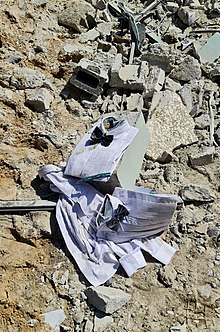
Wehda Street airstrikes
20/02/2022 14:51:28The Wehda Street airstrikes, known in Palestine as the Wehda Street massacre (Arabic: مجزرة شارع الوحدة), took place on May 16, 2021, when Israeli forces bombed al-Wehda Street, a densely populated area located in one of Gaza's most prominent residential and commercial neighbourhoods. The bombardment was the single deadliest operation in an 11-day conflict between Israel and Gaza that erupted after weeks of turmoil in East Jerusalem. Some 44 Palestinian civilians died and approximately 50 were injured in the strike, the heaviest of many that, in exchanges between the IDF and Gaza militants, left 2500 Palestinians homeless, and displaced tens of thousands.
The incident sparked outrage internationally. Israel stated the purpose of the attack was to destroy underground military infrastructure, including a Hamas command centre, though a New York Times investigation has suggested that they did not have precise information about the location of said command centre. An IDF spokesmen later said that the collateral damage was an unforeseen 'freak' consequence of a bombing run targeting tunnels under the street, and possibly due to secondary explosions. No advanced warning was given to Palestinian civilians in the area, with Israel stating that this was because they didn't expect this level of damage.
...




